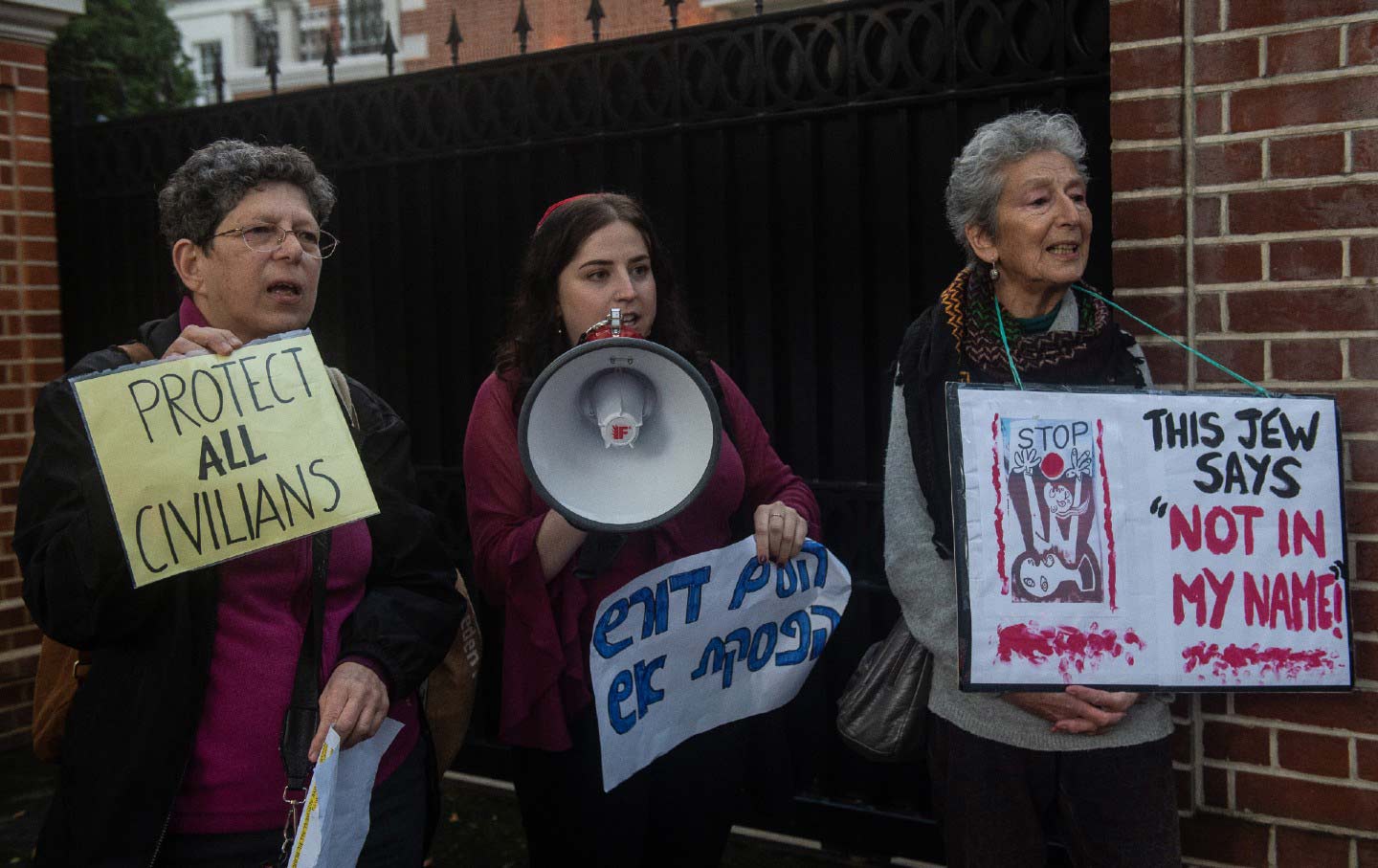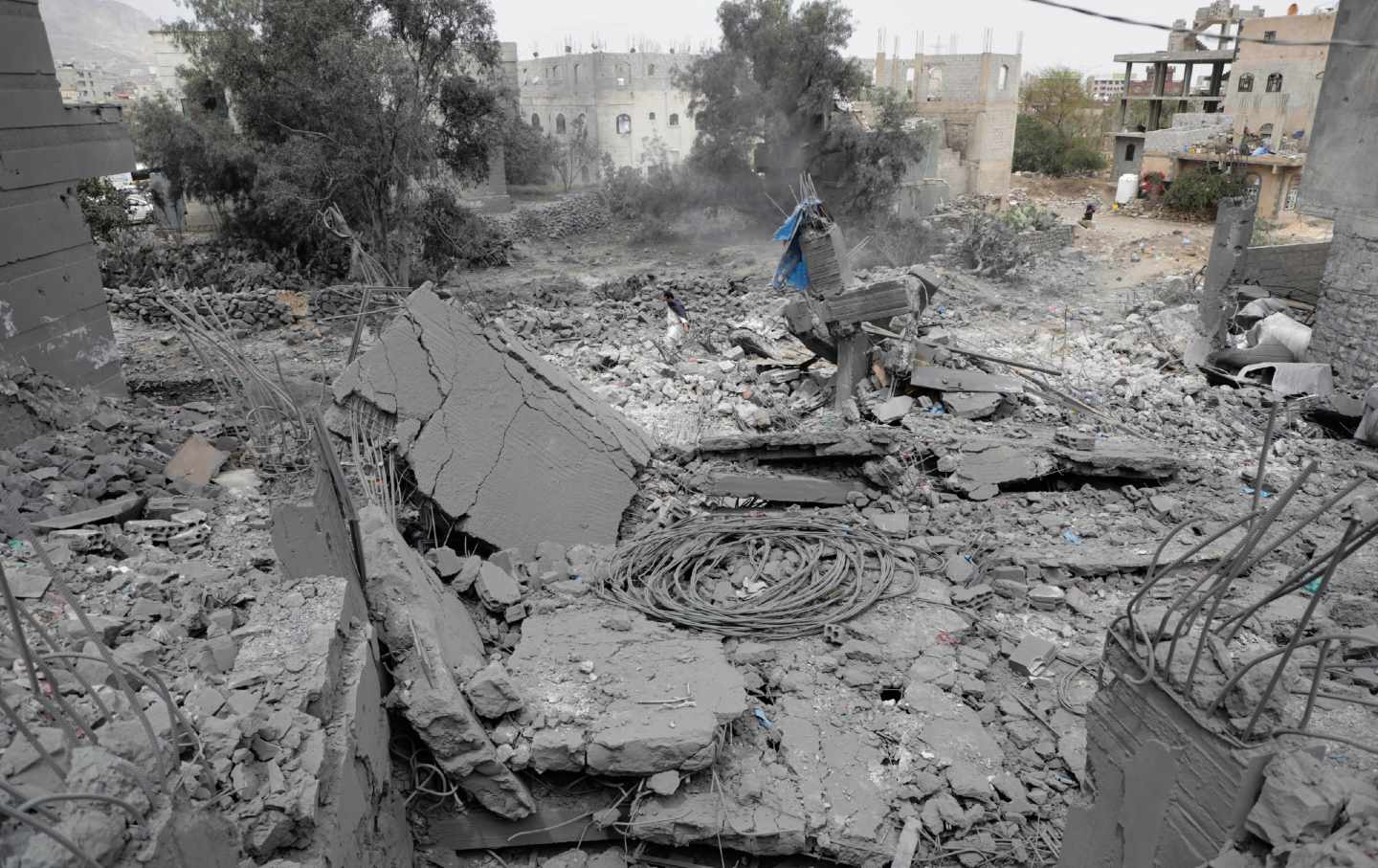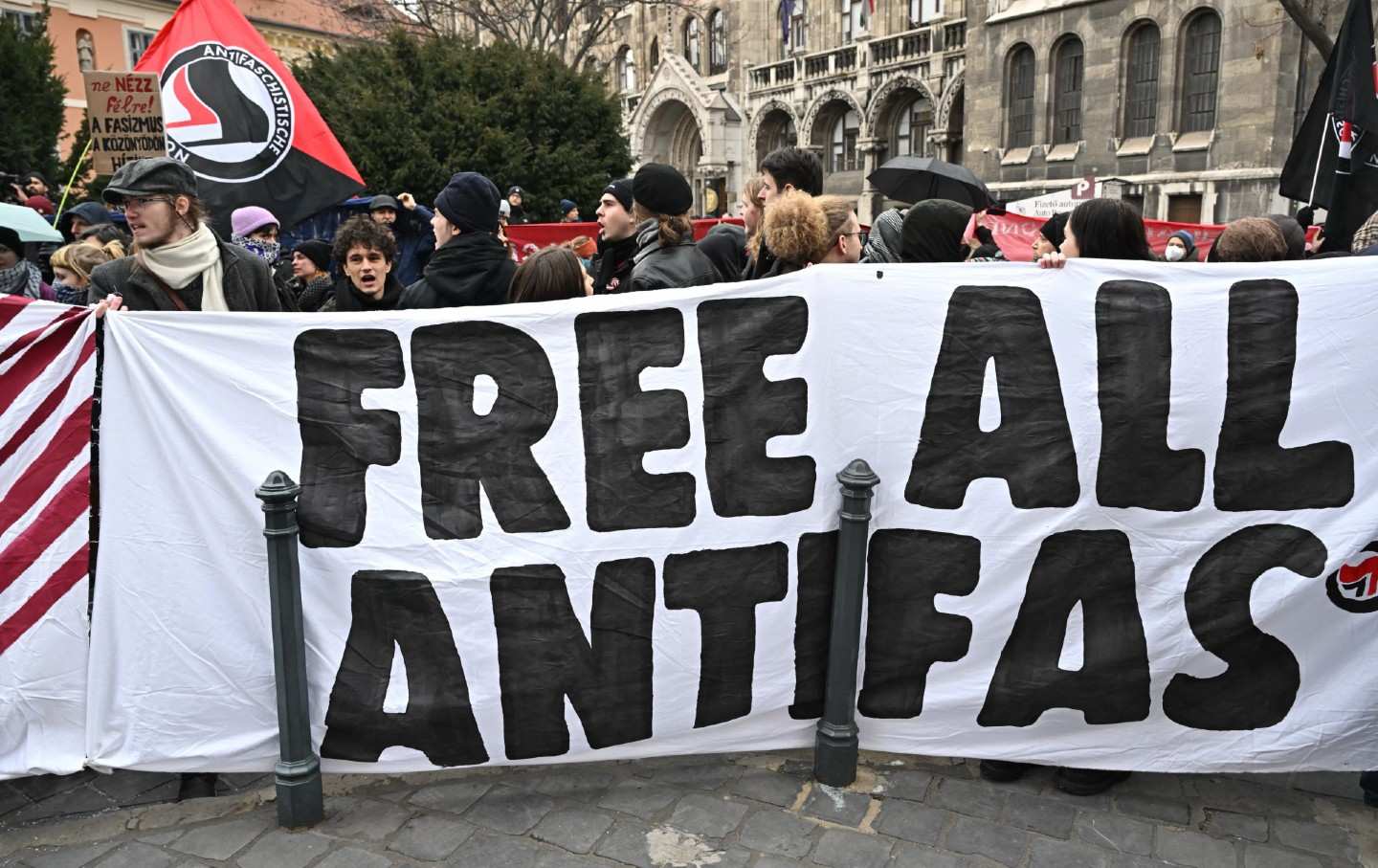Has London Really Become a “No-Go Zone” for Jews?
While antisemitism in the UK has certainly risen since October 7, politicians and newspapers are deliberately inflaming sensationalist narratives for a repressive agenda.

If you were a non-Jewish person living in the United Kingdom and didn’t know any better, you might think Jews are currently deserting London en masse. That’s certainly the impression you’d get from reading any of the major newspapers here recently.
“London’s antisemitism shame” was the headline splashed across the front page of the free commuter daily Evening Standard on March 5, accompanied by a warning that “Jewish families plan to flee capital amid rising tide of hatred.” “London is now a no-go zone for Jews,” proclaimed the front page of the right-wing broadsheet The Daily Telegraph three days later. The liberal online news site The Independent went even further, asserting that British Jews are considering leaving the country altogether, because it “feels like Nazi Germany.”
There has undoubtedly been a significant rise in antisemitism in the UK over the past five months, catalyzed by Hamas’s October 7 assault and Israel’s ongoing military offensive in Gaza. Even anecdotally, some friends whose Judaism is more visible than mine—because they wear kippot, for example, or a Star of David necklace—have experienced a spike in harassment and threats while going about their day-to-day lives.
But this narrative of London’s becoming a “no-go zone” for Jews has been deliberately built up and inflamed. Rather than stemming purely from concern for Jewish safety, it is being driven by a political agenda: to delegitimize and curtail the mass demonstrations in support of a cease-fire in Gaza that have filled the streets of central London on a near-weekly basis over the past five months.
Constructing a narrative
Despite some mainstream Jewish communal figures’ dismissing the sensationalist headlines about London as untrue and unhelpful, the established Jewish media and major organizations entrusted with combating antisemitism are continuing to amplify them. Their interests, it seems, are aligned with the Conservative government’s own ambition to crack down on dissent against Israel’s campaign of ethnic cleansing and starvation in Gaza.
From the very beginning, there has been a concerted effort by government ministers, echoed by much of the media commentariat, to create a moral panic around the cease-fire protests. Suella Braverman, who until November served as home secretary, repeatedly smeared the demonstrations as “hate marches.” (Braverman was eventually sacked after accusing the police of bias for not banning the protests altogether—a move that was widely understood as an opening gambit in her own bid for leadership of the Conservative party should Labour take power later this year, as it is expected to do.)
Braverman’s replacement, James Cleverly, continued where she left off and suggested that the protesters evinced “real evil intent.” Meanwhile, Prime Minister Rishi Sunak recently warned police, in reference to pro-cease-fire demonstrations, that the UK is descending into “mob rule.” In a national address at the start of March, Sunak further decried a “shocking increase in extremist disruption and criminality” since October 7.
And yet, if you ask any of the hundreds of thousands of people who have actually attended the protests, they’ll wonder what on earth these politicians are talking about. For one thing, the arrest rate at the demonstrations is lower than at a typical football match or the annual Glastonbury music festival.
Moreover, the crowds are probably the closest thing you will find to a representative cross section of British society: from toddlers to pensioners, and comprising virtually all ethnic, religious, and social backgrounds. That includes a substantial Jewish bloc, which some weeks has numbered more than 1,000 people—roughly tracking with Jews’ proportion in the British population as a whole.
So why the mass hysteria? There have certainly been isolated cases of protesters displaying offensive or racist placards within the marches. But the idea that these are typical of the protests as a whole—some of the largest in British history, peaking at more than half a million attendees in November—is ludicrous.
There has also been an attempt to vilify the rallies on the grounds that the popular chant “From the river to the sea, Palestine will be free” constitutes “a staple of antisemitic discourse,” as Braverman put it—or even a call for genocide. On the contrary, many marchers understand it as a straightforward call for the liberation of the Palestinian people from decades of Israeli occupation and apartheid—at a time when the International Court of Justice has deemed Israel’s actions in Gaza to be plausibly genocidal.
Beneath the headlines
Seeing such bombastic declarations splashed across the front pages of Britain’s leading newspapers, one may wonder how many Jewish people are actually being hounded out of the capital or the country. The truth is that it’s hard to know, because between them those articles quote a grand total of one Jewish person who, according to The Independent, is considering packing their bags in the coming months.
The source of the Telegraph’s “no-go zone” headline is the British government’s counter-extremism czar, Robin Simcox, who offers nothing to substantiate the claim. And while Braverman used the same phrase in the newspaper earlier in the week, she, too, didn’t back it with any evidence. A similar headline in Sky News quotes Jeremy Hunt, another Conservative MP and the current chancellor of the exchequer, whose evidence amounts to having “had emails from people.”
The Evening Standard offers us slightly more to go on, citing the results of a November survey by the Campaign Against Antisemitism showing that nearly half of the Jewish population nationwide has “considered leaving the UK” due to antisemitism since October 7. The article also refers to a new report by the Community Security Trust that documented over 4,000 antisemitic incidents across the UK in 2023—the most in one year since the organization began collecting data, and an 81 percent jump on the previous record in 2021.
Popular
“swipe left below to view more authors”Swipe →Such a significant spike is clearly cause for alarm for Britain’s small Jewish community, which comprises only around 0.5 percent of the total population. But these very real concerns are being cynically exploited by anti-Palestinian actors—both in the government and within the Jewish community itself.
First, it is important to understand a little more about the groups whose data is being cited. Despite its innocuous-sounding name, the Campaign Against Antisemitism (CAA) is a decidedly right-wing organization, as any review of the group’s posts on X (formerly Twitter), or its platforming of prominent anti-Muslim racists—will easily affirm.
Formed in 2014 amid what was Israel’s deadliest assault on Gaza prior to the current offensive, the CAA’s founding purpose, as the writer Michael Richmond recently characterized it, “was to counter the antisemitism that arises in Britain when Israel pummels Palestinians and, implicitly, to defend Israel’s right to pummel.” To that end, the CAA organized a national “March Against Antisemitism” in late November, positioning it in direct opposition to the cease-fire marches.
The CAA’s chief executive, Gideon Falter, is also the vice chair of JNK (Jewish National Fund) UK. Despite distancing itself from the organization of the same name in Israel (KKL-JNF)—which for over a century has been a central agent in the dispossession and displacement of Palestinians—JNF UK has in recent years funded the fringe right-wing movement Hashomer Hachadash, which Haaretz described as “Israel’s largest militia,” to the tune of around $1.3 million. It has also funded the CAA itself.
The Community Security Trust (CST), meanwhile, supplies security personnel for the protection of Jewish institutions across the country; it is also many Jewish people’s first port of call after experiencing antisemitic abuse. In response to the CST’s new report detailing a record spike in anti-Jewish incidents last year, Prime Minister Sunak pledged an additional £54 million (around $70 million) of government funding to the organization over the next four years.
Like the CAA, however, the CST is hardly a disinterested arbiter. For one thing, it appears to have an animus toward non- or anti-Zionist Jews—which is all the more concerning in light of recent polling showing that over a third of British Jews do not identify as Zionists.
Two recent examples illuminate these dynamics well. In January, the CST reportedly blocked a group of left-wing Jews from joining a march against antisemitism that it had co-organized in Manchester (the CST denies this, despite video evidence). And earlier this month, its chief executive, Mark Gardner, claimed in a BBC radio interview that the only Jews attending the cease-fire marches are either ultra-Orthodox (a reference to the Neturei Karta sect, which rejects the State of Israel on religious grounds) or “revolutionary socialists” who are “using their Jewishness so that people get the impression that this movement is not fundamentally antisemitic.”
Unpacking the data
But what of the CST’s widely cited statistics themselves? While a spike in antisemitism has certainly been felt across the UK, a close examination of the report raises a number of red flags that should disqualify it from being cited unquestioningly.
For starters, on the very first page of the executive summary, the CST argues that the record number of antisemitic incidents during the week following October 7 indicates that “it was the Hamas terror attack, rather than Israel’s military response in Gaza, that sparked most of the antisemitism,” and that this therefore constituted “a celebration of Hamas’ massacre.”
This is an irresponsible claim for two reasons. First, by October 11, Israel had cut off Gaza’s food, water, electricity, and fuel supply and begun a military campaign that had already killed roughly the same number of Palestinians in Gaza as the number of Israelis and foreign nationals killed during the Hamas-led assault four days earlier. And second, the CST’s own data shows that antisemitic incidents in the UK always surge in parallel with Israeli offensives on Gaza, irrespective of Palestinian attacks (its previous records were in May 2021, July 2014, and January 2009).
Another major red flag surrounds the issue of distinguishing criticism of Israel from antisemitism. In the report’s introduction, the CST cites the widely criticized International Holocaust Remembrance Alliance (IHRA) working definition of antisemitism as “a useful guide in identifying different types of antisemitic language.” This definition concerns itself largely with examples relating to criticism of Israel. It has been roundly castigated by academics, activists, civil liberties groups, and even its lead author for the way in which it has been weaponized to stifle free speech in support of Palestinian rights.
The figures cited in the CST report attest to this conflation of anti-Zionism (or even mere criticism of Israeli conduct) with antisemitism. Of the 4,103 incidents logged in 2023, nearly one-third (1,299) “exhibited anti-Zionist motivation.” The report does not offer any additional information as to the specific details of these incidents, only that “deciding on where the dividing lines lie [between criticism of Israel and antisemitism] is one of the most difficult areas of CST’s work.”
One category that illustrates this tension relates to the defacing of posters displaying photos and biographical information of the Israelis kidnapped by Hamas and other militant groups on October 7. The report states that 53 incidents were recorded “in which these posters were either ripped down or scrawled upon with antisemitic abuse.”
Yet there is clearly a substantive difference between ripping down a poster—an act that, no matter what one might think of it, could be born of frustration with the fact that they make no reference to the Palestinians being slaughtered in Gaza—and defacing it with antisemitic abuse (this page of the report is illustrated with a photo of a poster of a kidnapped Israeli baby that was vandalized with a swastika). In order to be able to have confidence in their figures, more transparency around the CST’s decision-making process in cases like these is essential.
It is also worth noting that among the more than 4,000 incidents recorded in 2023, almost a third were online (the majority of them on X); as with any online harassment, however, it is not always clear where the abusive user is based or if the perpetrator is even a real person.
Meanwhile, 6 percent of the incidents recorded constituted “assault,” none of which were classed as “extreme violence.” While each one of these incidents is a serious crime, breaking down the numbers is crucial to making a sober assessment of the problem, and to dispel some of the panic and hysteria surrounding the CST’s report and others like it.
Ensuring a secure future
Notwithstanding all these caveats, it cannot be ignored that nearly half of British Jews surveyed by the CAA said they have considered leaving the UK due to antisemitism since October 7. The UK’s Jewish community is, much like European Jewry as a whole, an anxiety-ridden one, for whom a readiness to take off at the drop of a hat is baked into our DNA (a similar number of Jews, it should be recalled, were reportedly considering leaving the country if then–Labour leader Jeremy Corbyn had been elected in 2019). But with the government advancing a repressive legislative agenda that is trampling on the right to protest, the cease-fire marches are providing the perfect excuse to instrumentalize Jews’ sense of insecurity.
At the same time, headlines like those seen in major newspapers over the past week serve only to further inflame such sentiments. And with incidents of Islamophobia also rising sharply since October 7, including from the mouths of senior politicians, there is a lot of work to be done to ensure that all of Britain’s ethnic and racial minorities feel that their future in the country is secure.
For their part, Jewish leadership organizations, including those that monitor and campaign against antisemitism, need to reckon with the fact that what may cause offense or discomfort does not necessarily equate to an attack on one’s identity. As Israel’s bombardment of 2.3 million besieged Palestinians enters its sixth month with no signs of letting up, and soldiers continue to broadcast their war crimes for all the world to see, it is more important than ever that Jews and non-Jews alike can draw a clear distinction between antisemitism and anti-Zionism. And for that, we need level heads and meaningful education, not scaremongering for political ends.
Support independent journalism that exposes oligarchs and profiteers
Donald Trump’s cruel and chaotic second term is just getting started. In his first month back in office, Trump and his lackey Elon Musk (or is it the other way around?) have proven that nothing is safe from sacrifice at the altar of unchecked power and riches.
Only robust independent journalism can cut through the noise and offer clear-eyed reporting and analysis based on principle and conscience. That’s what The Nation has done for 160 years and that’s what we’re doing now.
Our independent journalism doesn’t allow injustice to go unnoticed or unchallenged—nor will we abandon hope for a better world. Our writers, editors, and fact-checkers are working relentlessly to keep you informed and empowered when so much of the media fails to do so out of credulity, fear, or fealty.
The Nation has seen unprecedented times before. We draw strength and guidance from our history of principled progressive journalism in times of crisis, and we are committed to continuing this legacy today.
We’re aiming to raise $25,000 during our Spring Fundraising Campaign to ensure that we have the resources to expose the oligarchs and profiteers attempting to loot our republic. Stand for bold independent journalism and donate to support The Nation today.
Onward,
Katrina vanden Heuvel
Editorial Director and Publisher, The Nation








